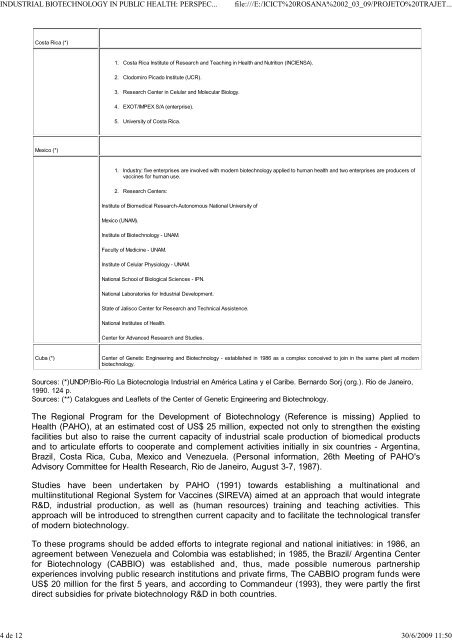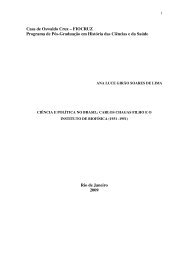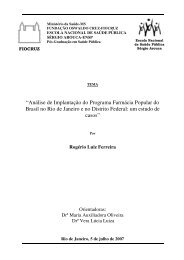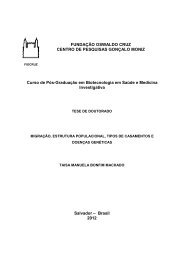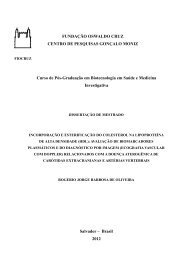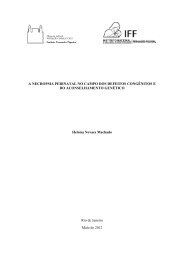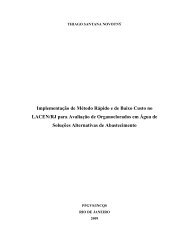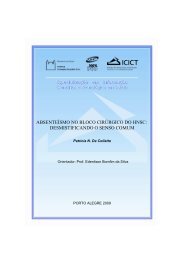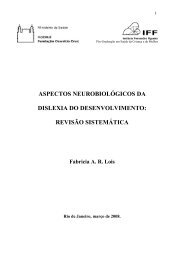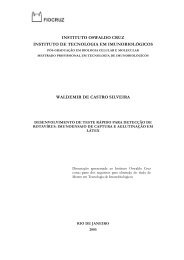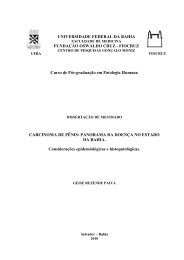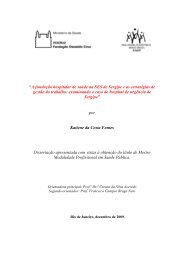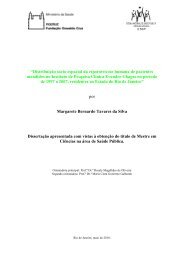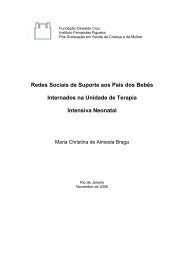industrial biotechnology in public health - Arca - Fiocruz
industrial biotechnology in public health - Arca - Fiocruz
industrial biotechnology in public health - Arca - Fiocruz
You also want an ePaper? Increase the reach of your titles
YUMPU automatically turns print PDFs into web optimized ePapers that Google loves.
INDUSTRIAL BIOTECHNOLOGY IN PUBLIC HEALTH: PERSPEC... file:///E:/ICICT%20ROSANA%2002_03_09/PROJETO%20TRAJET...<br />
Costa Rica (*)<br />
Mexico (*)<br />
1.<br />
2.<br />
3.<br />
4.<br />
5.<br />
1.<br />
2.<br />
Costa Rica Institute of Research and Teach<strong>in</strong>g <strong>in</strong> Health and Nutrition (INCIENSA).<br />
Clodomiro Picado Institute (UCR).<br />
Research Center <strong>in</strong> Celular and Molecular Biology.<br />
EXOT/IMPEX S/A (enterprise).<br />
University of Costa Rica.<br />
Industry: five enterprises are <strong>in</strong>volved with modern <strong>biotechnology</strong> applied to human <strong>health</strong> and two enterprises are producers of<br />
vacc<strong>in</strong>es for human use.<br />
Research Centers:<br />
Institute of Biomedical Research-Autonomous National University of<br />
Mexico (UNAM).<br />
Institute of Biotechnology - UNAM.<br />
Faculty of Medic<strong>in</strong>e - UNAM.<br />
Institute of Celular Physiology - UNAM.<br />
National School of Biological Sciences - IPN.<br />
National Laboratories for Industrial Development.<br />
State of Jalisco Center for Research and Technical Assistence.<br />
National Institutes of Health.<br />
Center for Advanced Research and Studies.<br />
Cuba (*) Center of Genetic Eng<strong>in</strong>eer<strong>in</strong>g and Biotechnology - established <strong>in</strong> 1986 as a complex conceived to jo<strong>in</strong> <strong>in</strong> the same plant all modern<br />
<strong>biotechnology</strong>.<br />
Sources: (*)UNDP/Bío-Río La Biotecnologia Industrial en América Lat<strong>in</strong>a y el Caribe. Bernardo Sorj (org.). Rio de Janeiro,<br />
1990. 124 p.<br />
Sources: (**) Catalogues and Leaflets of the Center of Genetic Eng<strong>in</strong>eer<strong>in</strong>g and Biotechnology.<br />
The Regional Program for the Development of Biotechnology (Reference is miss<strong>in</strong>g) Applied to<br />
Health (PAHO), at an estimated cost of US$ 25 million, expected not only to strengthen the exist<strong>in</strong>g<br />
facilities but also to raise the current capacity of <strong><strong>in</strong>dustrial</strong> scale production of biomedical products<br />
and to articulate efforts to cooperate and complement activities <strong>in</strong>itially <strong>in</strong> six countries - Argent<strong>in</strong>a,<br />
Brazil, Costa Rica, Cuba, Mexico and Venezuela. (Personal <strong>in</strong>formation, 26th Meet<strong>in</strong>g of PAHO's<br />
Advisory Committee for Health Research, Rio de Janeiro, August 3-7, 1987).<br />
Studies have been undertaken by PAHO (1991) towards establish<strong>in</strong>g a mult<strong>in</strong>ational and<br />
multi<strong>in</strong>stitutional Regional System for Vacc<strong>in</strong>es (SIREVA) aimed at an approach that would <strong>in</strong>tegrate<br />
R&D, <strong><strong>in</strong>dustrial</strong> production, as well as (human resources) tra<strong>in</strong><strong>in</strong>g and teach<strong>in</strong>g activities. This<br />
approach will be <strong>in</strong>troduced to strengthen current capacity and to facilitate the technological transfer<br />
of modern <strong>biotechnology</strong>.<br />
To these programs should be added efforts to <strong>in</strong>tegrate regional and national <strong>in</strong>itiatives: <strong>in</strong> 1986, an<br />
agreement between Venezuela and Colombia was established; <strong>in</strong> 1985, the Brazil/ Argent<strong>in</strong>a Center<br />
for Biotechnology (CABBIO) was established and, thus, made possible numerous partnership<br />
experiences <strong>in</strong>volv<strong>in</strong>g <strong>public</strong> research <strong>in</strong>stitutions and private firms, The CABBIO program funds were<br />
US$ 20 million for the first 5 years, and accord<strong>in</strong>g to Commandeur (1993), they were partly the first<br />
direct subsidies for private <strong>biotechnology</strong> R&D <strong>in</strong> both countries.<br />
4 de 12 30/6/2009 11:50


